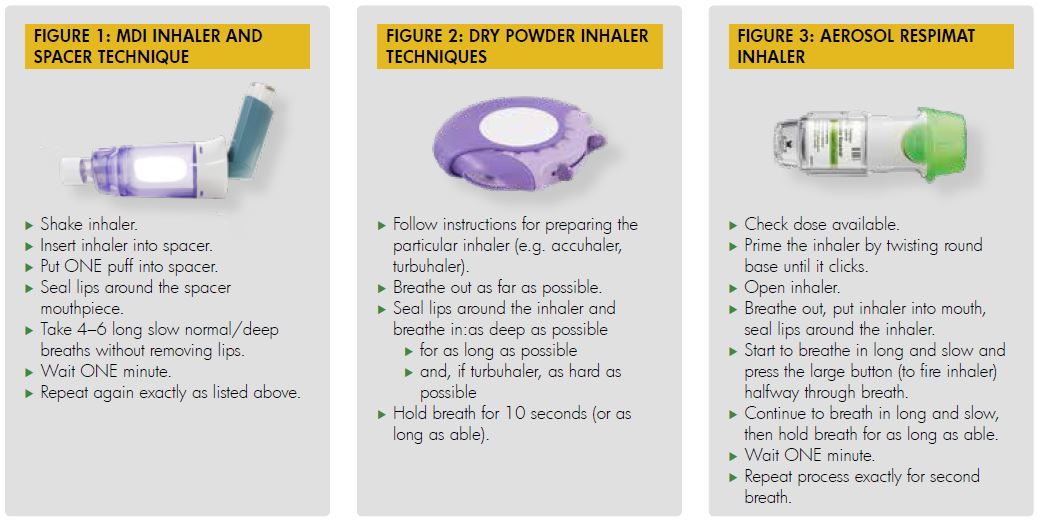On the worst day in winter our respiratory department can have as many as 70 inpatients – the vast majority ‘outliers’ dotted in non-respiratory wards across the hospital.
Ward rounds become a ‘safari’ that can take a whole day and involve visiting most of the wards in the hospital. During winter – despite careful bed allocation by managers – nurses on surgical or gynae wards can find themselves nursing patients with acute respiratory needs.
Often these nurses struggle to remember nursing priorities for these patients, and the respiratory teams managing these patients can also forget that this is maybe the first unwell respiratory patient that nurse has had to care for in up to a year – that is, since last winter saw very sick respiratory patients arrive on their ward.
Understanding this and providing timely, easy to understand and easily accessible education can help prevent tempers becoming frayed.
Managing inpatient asthma
People still die from asthma in New Zealand – more than 60 a year – often because they have poor understanding of their disease and how to treat it. Sometimes, however, deaths can be due to mixed messages from healthcare professionals or difficulty accessing inhalers. Many who die have been in hospital in the year before their deaths – a missed opportunity for a consistent education message.
Asthma patients need to continue their preventative medicine at all times, well or ill, so early access to their usual inhalers, or those prescribed by the team, is key.
Most preventative inhalers are taken twice a day, so not realising until the evening drugs round that the inhaler needs to be ordered from pharmacy can mean the patient goes without their preventative corticosteroid (ICS) inhalers for up to 36 hours. Not the message we want to give them in winter! Therefore it is important inhalers are requested from pharmacy as soon as they are prescribed.
Checking the patient’s inhaler technique is also key to ensuring they treat their illness properly. All patients (and often many clinicians) think they know how to use inhalers correctly, but in reality patients’ inhaler technique is often poor and likewise clinicians’ observations, corrections, and documentation of inhaler techniques. (To see how bad – and to give yourself a smile – search for the ‘inhaler’ clip from the House TV series on YouTube.)
Refresher on using inhalers
Clinicians need to know how to use inhalers correctly according to the manufacturer’s instructions.
The best way to do this is to read the instructions from the packet before you give the inhaler to the patient, but it helps to have a crib sheet in the medication room, such as the poster I developed for wards around Waikato Hospital.
The worst thing a clinician can do is give the wrong information as this creates a false belief, and confusion and distrust in the future.
There are many inhaler devices on the market, but basically they fall into two groups – aerosol and dry powder.
It is generally accepted now that all metered dose aerosol inhalers (MDI) are best taken via a spacer and in our hospital we advocate the tidal breathing method (see Figure 1 below). Only one puff of the inhaler should be put into the spacer at any time (any others are not absorbed).
Dry powder inhalers are prepared differently for each inhaler (adding a capsule, checking the dose and twisting the base or opening a lid) but the inhalation technique is the same – emptying the lungs of air by breathing out, sealing lips around the mouthpiece and then breathing in for as long as possible to place the drug in the lungs, finally holding that breath for as long as possible (see Figure 2 below).
The aerosol respimat inhaler (usually only used in COPD) has many steps to using correctly so nurses should always familiarise themselves with the instructions before educating patients (see Figure 3 below).
Patients should always be observed taking their inhalers in the same way you should watch a patient swallowing a tablet. This is still a prescribed drug, and only if you yourself have observed a patient taking an inhaler, do you know if their technique is correct. And then make sure you document it!
Oxygen therapy should only be given as prescribed. For asthmatics it is only required if saturations cannot be maintained. It should only be used for COPD patients if their saturations fall below 88 per cent; administration when unnecessary can cause harm.
Careful observations and assessments needed
Asthma patients are often worse at night so need careful observation and easy access to their reliever medication – often salbutamol or a short – acting bronchodilator (SABA).
In contrast, other respiratory patients are often exhausted by the effort of breathing and need plenty of rest at night, so may need a quieter bay or single room.
Eating is always an effort when breathless so careful observation of dietary intake, more time to eat, smaller portions and sometimes direct help maybe needed.
Severity of asthma is assessed by many criteria including peak flow reading and often a patient’s suitability for discharge is judged by improvement in peak flow reading. Asthma patients should have a peak flow done as early in their admission as possible, when low, to help facilitate discharge when the reading improves.
After that initial reading, peak flow needs to be done just twice daily. Single-patient-use peak flow meters should be used and sent home with the patient on discharge.
Medication adherence reduces risk of winter hospitalisations
An admission to hospital with asthma is almost always due to poor control.
Careful questioning of patients often reveals that they forgot or ran out of inhalers or ignored avoidance advice. Therefore it is really important that any asthmatic patients that end up in hospital for an exacerbation of asthma are followed up by specialist clinicians as outpatients.
They should also have a written plan outlining their medication, how and when to take it and what to do if their symptoms worsen or in an emergency. If no local forms are available, the New Zealand Asthma Guidelines and Asthma Foundation both have accessible versions that can be used.
Patients who have run out of medication should have a prescription for medication to avoid further admissions during the peak season.
Respiratory patients should spend as little time as possible in hospital as they are prone to hospital acquired infections, and so managing their acute illness as quickly as possible during their admission is key.
Average length of stay can be two to three days. This means they may be discharged while still in the early recovery period of their illness, so may need earlier review and easier access to their usual medications in the community – remember it can take up to one week for every decade the person has lived, to start to recover properly from their infection. This can mean they need support in the community.
Discharged respiratory patients may need a ‘rescue prescription’ of antibiotics and oral steroids to allow them to start treatment while waiting for contact with their GP or NP (but not instead of contact).
This prescription is always best managed by their general practice to monitor appropriate use. Patients should have clear instructions for initiating and completing the course and about contacting their general practice.
Community support in winter
Respiratory patients are among the group that can suffer the most serious complications of flu and so immunisation is key.
There is a misconception among patients that the flu vaccine causes illness, but often the cause is attending the healthcare provider and sharing a waiting room with sick people, so dedicated flu clinics outside of normal surgery hours can help prevent this.
It is important to identify the cause of infection quickly, so a sputum sample should be collected in the first 12 hours (before antibiotics kick in). Identifying the causative pathogen can prevent further admissions by tailoring antibiotic treatment.
It is important that the sample is sputum, not saliva, as this won’t be processed by the laboratory. They may often need physiotherapy intervention for sputum clearance and breathing control.
Having a sputum sample before treating an infection is just as valuable in the community and providing a labelled sample pot for when the patient becomes unwell can often inform future prescribing and shorten the illness.
During flu season nasopharyngeal swabs for influenza are often requested. These need to be specific swabs and must be documented as nasopharyngeal on the form to be processed.
When bad weather is expected, taking time to check the most vulnerable patients have access to their usual medications can often also help prevent illness and hospital admissions. The UK’s Met Office found that hospitalisations peaked seven to 10 days after a cold weather event.
With nurses in the community and hospitals working together to support respiratory patients, it is hoped that more patients will keep well or have shorter illnesses this winter.
Priorities for inpatients
- Access inhalers as soon as possible.
- Asthma patients need peak flows on arrival and then twice daily.
- Patients with infection need early sputum samples.
- Observe patients using their inhalers and document.
- Give consistent correct information.
- Carefully planned discharge and follow up plan.
- Prioritise rest, careful nutrition and observation.
Priorities in the community
- Keep well respiratory patients away from the medical centre in winter (to reduce the risk of being exposed to sick patients in the waiting room).
- For the same reason, consider having dedicated after-hours flu immunisation clinics.
- Ensure patients have clear treatment plans and access to medication.
- Know your vulnerable patients and plan for the worst weeks of winter.
- Collect sputum samples early to speed up treatment.
- Follow up discharged respiratory patients who may need support.


























